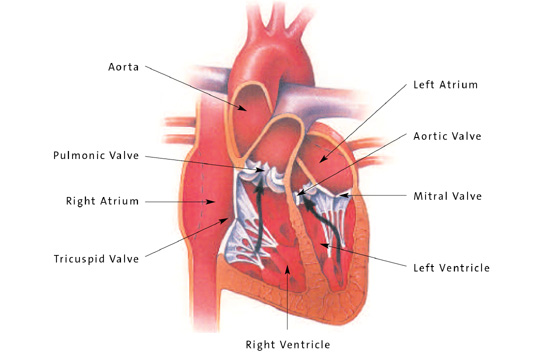The heart is a pear-shaped organ about the size of a fist. It is located just to the left of the middle of the chest. The heart muscle pumps blood nonstop to all parts of the body.

The heart is a hollow organ with four chambers. The top chambers are the right and left atria. The bottom chambers are the right and left ventricles. Blood from the body returns to the heart and enters the right atrium. The right atrium pushes the blood through the tricuspid valve into the right ventricle. From the right ventricle, blood is pumped through the pulmonic valve and pulmonary artery to the lungs, where it picks up oxygen. The oxygen rich blood returns to the heart through the pulmonary veins and into the left atrium. The left atrium sends the blood through the mitral valve into the left ventricle. The large muscular left ventricle contracts and pumps the oxygen rich blood through the aortic valve, into the aorta and then to all parts of the body. Blood is then collected in the venous system and returns to the right atrium and the cycle begins again.

The heart muscle must also provide oxygen rich blood to itself. The coronary arteries, which lie on the outside of the heart, supply the heart muscle with oxygenated blood. These arteries branch off the aorta, the large blood vessel that transports blood from your heart to the rest of your body.
The first two arteries which come directly off the aorta are the left main coronary artery and the right coronary artery. The left main coronary artery branches into the left anterior descending artery and the circumflex artery. The left anterior descending artery supplies blood to the front of the heart. The circumflex artery supplies the back and left side of the heart. The right coronary artery supplies blood to the right side, the bottom, and the back of the heart.